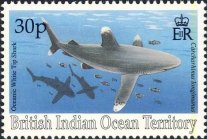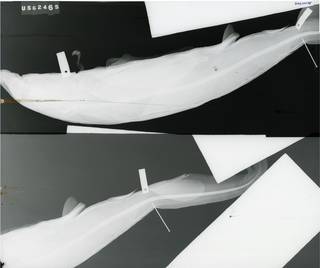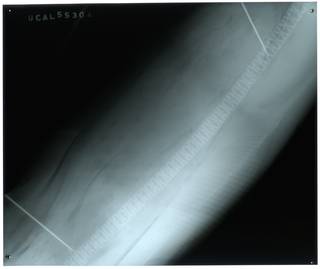Deep-Sea taxon details
Carcharhinus longimanus (Poey, 1861)
105794 (urn:lsid:marinespecies.org:taxname:105794)
accepted
Species
marine, brackish, fresh, terrestrial
Not documented
Description Oceanic (Ref. 9987). A deep water species which seldom comes close to shore. Preferred water temperatures range from 18 to...
Distribution Gulf of Maine (near NE edge Georges Bank - Scott & Scott, 1988) to Argentina
Description Oceanic (Ref. 9987). A deep water species which seldom comes close to shore. Preferred water temperatures range from 18 to 28°C. Frequently accompanied by @Remora@ and @Coryphaena@, and tortoises. Feeds mainly on pelagic fish and cephalopods. There is pronounced partial segregation by size and sex in some areas.This is an active, almost fearless shark also charged in human attacks. Utilized for human consumption, for leather, for finsoup, and for oil. Marketed fresh, dried-salted and frozen (Ref. 9987). [details]
Distribution Gulf of Maine (near NE edge Georges Bank - Scott & Scott, 1988) to Argentina
Distribution Gulf of Maine (near NE edge Georges Bank - Scott & Scott, 1988) to Argentina [details]
Froese, R. and D. Pauly. Editors. (2024). FishBase. Carcharhinus longimanus (Poey, 1861). Accessed through: Glover, A.G.; Higgs, N.; Horton, T. (2024) World Register of Deep-Sea species (WoRDSS) at: https://www.marinespecies.org/DeepSea/aphia.php?p=taxdetails&id=105794 on 2024-04-20
Glover, A.G.; Higgs, N.; Horton, T. (2024). World Register of Deep-Sea species (WoRDSS). Carcharhinus longimanus (Poey, 1861). Accessed at: https://www.marinespecies.org/deepsea/aphia.php?p=taxdetails&id=105794 on 2024-04-20
Date
action
by
context source (Deepsea)
Intergovernmental Oceanographic Commission (IOC) of UNESCO. The Ocean Biogeographic Information System (OBIS), available online at http://www.iobis.org/ [details]
context source (Bermuda) Smith-Vaniz, W. F.; Collette, B. B.; Luckhurst, B. E (1999). Fishes of Bermuda: History, zoogeography, annotated checklist, and identification keys (American Society of Ichthyologists and Herpetologists - Special Publication No.4) . ASIH, 424 pp. [details]
context source (PeRMS) Chirichigno, N.; Cornejo, M. (2001). Catálogo comentado de los peces marinos del Perú. <em>2ª ed. Instituto del Mar de Perú. Publicación Especial. Callao.</em> 314 p. [details]
basis of record van der Land, J.; Costello, M.J.; Zavodnik, D.; Santos, R.S.; Porteiro, F.M.; Bailly, N.; Eschmeyer, W.N.; Froese, R. (2001). Pisces, <B><I>in</I></B>: Costello, M.J. <i>et al.</i> (Ed.) (2001). <i>European register of marine species: a check-list of the marine species in Europe and a bibliography of guides to their identification. Collection Patrimoines Naturels,</i> 50: pp. 357-374 (look up in IMIS) [details]
additional source Garrick, J.A.F. (1982). Sharks of the genus Carcharhinus. <em>NOAA Technical Report NMFS Circular.</em> 445:150-159. [details]
additional source Smith, J.L.B. & Smith, M.M. (1963). The fishes of Seychelles. Department of Ichthyology, Rhodes University. Grahamstown. [details]
additional source King, C.M.; Roberts, C.D.; Bell, B.D.; Fordyce, R.E.; Nicoll, R.S.; Worthy, T.H.; Paulin, C.D.; Hitchmough, R.A.; Keyes, I.W.; Baker, A.N.; Stewart, A.L.; Hiller, N.; McDowall, R.M.; Holdaway, R.N.; McPhee, R.P.; Schwarzhans, W.W.; Tennyson, A.J.D.; Rust, S.; Macadie, I. (2009). Phylum Chordata: lancelets, fishes, amphibians, reptiles, birds, mammals. <em>in: Gordon, D.P. (Ed.) (2009). New Zealand inventory of biodiversity: 1. Kingdom Animalia: Radiata, Lophotrochozoa, Deuterostomia.</em> pp. 431-554. [details]
additional source McEachran, J. D. (2009). Fishes (Vertebrata: Pisces) of the Gulf of Mexico, Pp. 1223–1316 in: Felder, D.L. and D.K. Camp (eds.), Gulf of Mexico–Origins, Waters, and Biota. Biodiversity. Texas A&M Press, College Station, Texas. [details]
additional source Liu, J.Y. [Ruiyu] (ed.). (2008). Checklist of marine biota of China seas. <em>China Science Press.</em> 1267 pp. (look up in IMIS) [details] Available for editors
additional source Froese, R. & D. Pauly (Editors). (2023). FishBase. World Wide Web electronic publication. version (02/2023)., available online at https://www.fishbase.org [details]
context source (Bermuda) Smith-Vaniz, W. F.; Collette, B. B.; Luckhurst, B. E (1999). Fishes of Bermuda: History, zoogeography, annotated checklist, and identification keys (American Society of Ichthyologists and Herpetologists - Special Publication No.4) . ASIH, 424 pp. [details]
context source (PeRMS) Chirichigno, N.; Cornejo, M. (2001). Catálogo comentado de los peces marinos del Perú. <em>2ª ed. Instituto del Mar de Perú. Publicación Especial. Callao.</em> 314 p. [details]
basis of record van der Land, J.; Costello, M.J.; Zavodnik, D.; Santos, R.S.; Porteiro, F.M.; Bailly, N.; Eschmeyer, W.N.; Froese, R. (2001). Pisces, <B><I>in</I></B>: Costello, M.J. <i>et al.</i> (Ed.) (2001). <i>European register of marine species: a check-list of the marine species in Europe and a bibliography of guides to their identification. Collection Patrimoines Naturels,</i> 50: pp. 357-374 (look up in IMIS) [details]
additional source Garrick, J.A.F. (1982). Sharks of the genus Carcharhinus. <em>NOAA Technical Report NMFS Circular.</em> 445:150-159. [details]
additional source Smith, J.L.B. & Smith, M.M. (1963). The fishes of Seychelles. Department of Ichthyology, Rhodes University. Grahamstown. [details]
additional source King, C.M.; Roberts, C.D.; Bell, B.D.; Fordyce, R.E.; Nicoll, R.S.; Worthy, T.H.; Paulin, C.D.; Hitchmough, R.A.; Keyes, I.W.; Baker, A.N.; Stewart, A.L.; Hiller, N.; McDowall, R.M.; Holdaway, R.N.; McPhee, R.P.; Schwarzhans, W.W.; Tennyson, A.J.D.; Rust, S.; Macadie, I. (2009). Phylum Chordata: lancelets, fishes, amphibians, reptiles, birds, mammals. <em>in: Gordon, D.P. (Ed.) (2009). New Zealand inventory of biodiversity: 1. Kingdom Animalia: Radiata, Lophotrochozoa, Deuterostomia.</em> pp. 431-554. [details]
additional source McEachran, J. D. (2009). Fishes (Vertebrata: Pisces) of the Gulf of Mexico, Pp. 1223–1316 in: Felder, D.L. and D.K. Camp (eds.), Gulf of Mexico–Origins, Waters, and Biota. Biodiversity. Texas A&M Press, College Station, Texas. [details]
additional source Liu, J.Y. [Ruiyu] (ed.). (2008). Checklist of marine biota of China seas. <em>China Science Press.</em> 1267 pp. (look up in IMIS) [details] Available for editors
additional source Froese, R. & D. Pauly (Editors). (2023). FishBase. World Wide Web electronic publication. version (02/2023)., available online at https://www.fishbase.org [details]
 Present
Present  Inaccurate
Inaccurate  Introduced: alien
Introduced: alien  Containing type locality
Containing type locality
From other sources
Description Oceanic (Ref. 9987). A deep water species which seldom comes close to shore. Preferred water temperatures range from 18 to 28°C. Frequently accompanied by @Remora@ and @Coryphaena@, and tortoises. Feeds mainly on pelagic fish and cephalopods. There is pronounced partial segregation by size and sex in some areas.This is an active, almost fearless shark also charged in human attacks. Utilized for human consumption, for leather, for finsoup, and for oil. Marketed fresh, dried-salted and frozen (Ref. 9987). [details]Diet Feeds mainly on bony fishes, other sharks, rays, turtles, seabirds, maine mammals, molluscs, crustaceans, and carrion [details]
Distribution Gulf of Maine (near NE edge Georges Bank - Scott & Scott, 1988) to Argentina [details]
Habitat nektonic [details]
Habitat Mainly oceanic, found along the coast in tropical and warm temperate waters. [details]
Importance Social- Fishey and gamefish, dangerous to humans; the object of longline or gill net fisheries for meat, fins liver, oil, fish meal, hides and teeth [details]
| Language | Name | |
|---|---|---|
| English | oceanic whitetip shark | [details] |
| German | Weißspitzen-HochseehaiHochsee-Weißflossenhai | [details] |
| Japanese | ヨゴレ | [details] |
| Lithuanian | ilgapelekis pilkasis ryklys | [details] |
| Modern Greek (1453-) | Καρχαρίνος των ωκεανών | [details] |
| Polish | żarłacz białopłetwy | [details] |
| Spanish | tiburón oceánicojaquetón de ley | [details] |
| Swedish | årfenhaj | [details] |
| Turkish | akyüzgeçli köpekbalığıakyuzgecli kopekbaligi | [details] |
| Ukrainian | Довгокрила акулаАкула сіра довгокрила | [details] |
To Barcode of Life (69 barcodes)
To Biodiversity Heritage Library (26 publications)
To Biological Information System for Marine Life (BISMaL)
To Dyntaxa
To European Nucleotide Archive (ENA)
To FishBase
To FishBase images (Carcharhinus longimanus, Egypt, by Moldzio, S.)
To GenBank (430 nucleotides; 271 proteins)
To Global Biotic Interactions (GloBI)
To IUCN Red List (Critically Endangered)
To NMNH Extant Collection (Carcharhinus longimanus RAD100158-001)
To NMNH Extant Collection (Carcharhinus longimanus RAD100159-003)
To PESI
To ITIS
To Biodiversity Heritage Library (26 publications)
To Biological Information System for Marine Life (BISMaL)
To Dyntaxa
To European Nucleotide Archive (ENA)
To FishBase
To FishBase images (Carcharhinus longimanus, Egypt, by Moldzio, S.)
To GenBank (430 nucleotides; 271 proteins)
To Global Biotic Interactions (GloBI)
To IUCN Red List (Critically Endangered)
To NMNH Extant Collection (Carcharhinus longimanus RAD100158-001)
To NMNH Extant Collection (Carcharhinus longimanus RAD100159-003)
To PESI
To ITIS











